How To Stake Your Lawn For Winter
Guide to Staking Your Lawn for Winter
Throughout the spring, summer and fall, you’ve worked hard to protect your beautiful lawn. You’ve raked, aerated, fertilized, watered and even mulched your grass until it achieved perfect health and a magazine-worthy appearance. But on the first winter day when that heavy snow dump suddenly arrives, your masterpiece disappears under a thick, white blanket.
That’s when the snow plowing starts and mounds pile up. There’s one problem, though, and it’s a big problem. Your snow plow operator has no reference point to tell where the roadway ends and your lawn edge begins. Your lawn and every other hidden entity are at risk of being struck by the plow blade.
However, you can easily avoid this costly damage by staking your lawn for the winter.
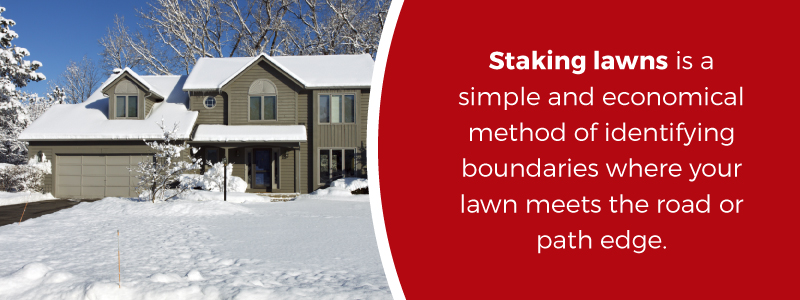
What Is Staking Your Lawn?
You’re probably wondering what staking your lawn is. You’re also likely questioning why people do stake their lawns and why staking your lawn in the winter is important. Staking lawns is a simple and economical method of identifying boundaries where your lawn meets the road or path edge. This clearly demarcates where a snow plow operator can safely travel without striking a hidden hazard or valuable soft surface like your lawn.
Every winter, expensive damage happens when plow drivers accidentally strike snow-covered objects. Operators don’t intend on creating problems for homeowners. They’re working with all good intentions, but they might unknowingly hit objects that aren’t visible or marked. Snow plow operators can damage more than your property, too. Connecting with a solid surface like a rock or concrete curb can seriously damage their machinery as well.
No one wants to lay fault or blame for these snow-covered mishaps. That’s no value for any side. But, the reality is that snow plow strikes are expensive, and someone has to absorb the repair bills. Using snow stakes, also called driveway markers, is that ounce of prevention worth pounds of cure.
Snow stakes are tall, thin poles you insert in the ground to identify objects and edges that become covered by winter’s snowfall. These simple visual aids are one of the best tips for easy snow plowing you can get. The idea is so simple. Snow stake markers are common in large snowfall areas that need human snow removal rather than waiting for Mother Nature to melt it away.
Staking your grassy boundaries is prime lawn protection. A plow operator has no reference point where your lawn starts and the road they’re plowing stops when a continuous white sheet makes delineation impossible to see. But a series of highly visible stakes sticking far above the snow surface simply can’t be missed. Stakes are the cheapest insurance you can buy for the best preventive return.
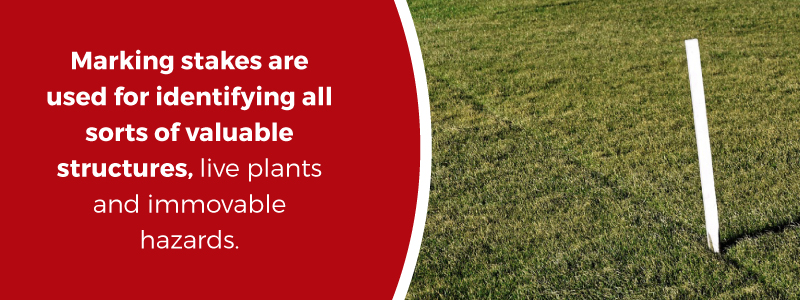
Marking Other Snow Plow Hazards
Lawn edges aren’t the only thing snow stakes protect. Marking stakes are used for identifying all sorts of valuable structures, live plants and immovable hazards. Stakes are handy to mark out:
- Concrete curbs and sidewalk locations
- Fire hydrants
- Utility connection boxes
- Catch and drain basins
- Retaining walls
- Guardrails
- Garden beds and shrub plantings
- Stumps and boulders
- Decorative garden features
- Patio lips and edges
- Drainage ditches
- Culverts and water pipes
- Buried cable accesses
- Driveway entrances
- Driveway stops
All these landscape features easily disappear under a one-foot snowfall, never mind heavy storms that release two to three feet at a time. Big snowfalls in short timespans require immediate snow removal in busy locations. In those situations, finding a snow plow in a hurry can be difficult. Then, getting an operator who’s familiar with your individual property and all its hazards might be downright impossible.
The safest solution to protect your valuable softscape and hardscape features is taking preventive steps to stake each hazard or boundary with clearly identifiable snow plow limit markers. Doing this inexpensive and proactive task might save you and your plow company from hundreds or even thousands of dollars in damages. It’s just that important.
What Makes an Effective Lawn Stake
These are other really good questions. Many people might not have heard about lawn staking, never mind the different kind of stakes available. If you’re one of them, you likely don’t know where to use limit markers.
Marking stakes should be used every place you feel there’s an obstacle that might get struck by a snow plow. That includes government plows working past your driveway access as well as privately contracted snowplows working on your private property. Whether plow operators are private or public, they are faced with the same limited visibility issues. It’s your responsibility to make their plowing job easier and safer.
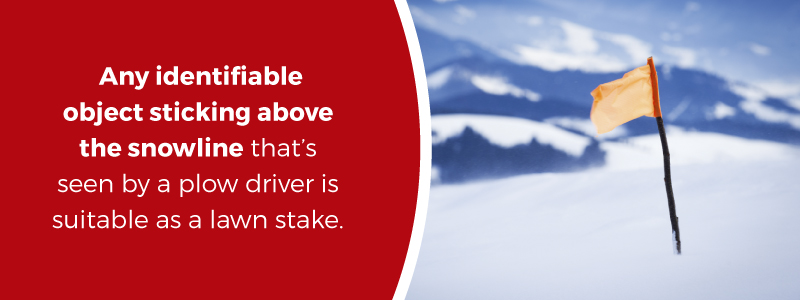
There’s no correct type of stake. Any identifiable object sticking above the snowline that’s seen by a plow driver is suitable. That’s in theory, of course. Some stake materials are considerably better than others. You want your driveway and lawn marking stakes to accomplish a few different tasks. Consider these performance markers:
- Height: Lawn markers need to be tall enough to remain exposed under the entire winter snowfall coverage. Most commercial snow stakes start at four feet. Some are available as tall as eight feet for those really deep snow areas like at high elevations and snow-belt locations. The average store-bought markers measure five to six feet.
- Visibility: You need your snow markers to stand out. They have to catch the plow operator’s eye immediately and leave no doubt about the hazard warning. Many lawn and edge markers are brightly colored and have reflective materials on the top. This clearly shows they are intentional markers protecting a definite plowing hazard. High-visibility markers are also excellent performers in low-light conditions as well as in the middle of a storm.
- Durability: Drive and lawn markers have to be tough. Markers are continuously exposed to the elements. That includes snow weight and wind forces. Marking stakes get ice-covered and suffer through freeze-thaw cycles. They’re subject to rot and rust at ground level as well as being struck by an inattentive plow operator. Your stakes should also be reusable. Quality stakes can be put into service year after year. An initial investment in durable stakes pays off down the road.
- Uniformity: There must be no doubt what your lawn stakes are. Plow operators need to know at a glance that these makers are intentionally placed and mean business. If you have a pipe here and a broken hockey stick there, it’s going to present a puzzle. Even if you tie flagging tape to the top of a tree branch jammed in the ground, a new plow operator will wonder what it means. This is where professionally made and commercially purchased snow stakes really add value.
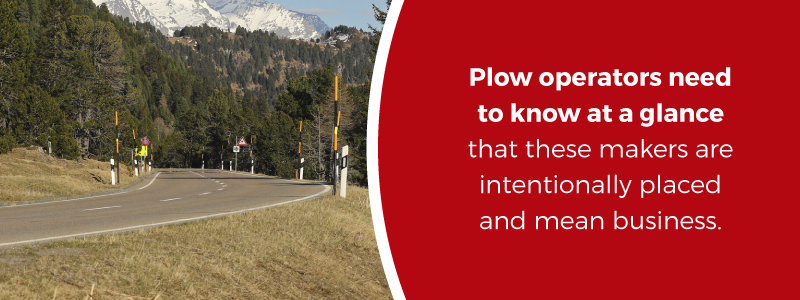
Height, visibility, durability and uniformity are the four main performance parameters to consider when selecting the right marker stakes for your winter protection. Budget might also be a concern for some homeowners who are tempted to use scrap materials for lawn markers. This usually won’t pay off, as you’re unlikely to convey a meaningful message to your plow person.
Lawn Stake Materials
Like stake parameters, there are four performance materials available for snow markers. Each material has its pros and cons. There’s also a variable in cost. A word of advice when deciding what marker stake material is best property protection is to buy stakes that will be clearly seen, send a message and stand up as well as out. These are your standard snow stake materials:
- Wood: This is a basic snow stake material. Wood has been used for boundary markers for decades, as it’s cheap and plentiful. Many folks who use wooden stakes accept that they’re likely to be a one-season installment they replace every year. Wood stakes are usually top-marked with spray paint or surveyor’s tape. Wood stakes’ drawback is they are weak and won’t resist a blade strike or even a hard wind against a frozen surface.
- Fiberglass: Snow stakes made from fiberglass are excellent investments. They’re relatively inexpensive considering the long life fiberglass has. Fiberglass is strong and flexible as well. These stakes are thin, ranging from 1/4 to 5/16 inch diameters. Thin profiles cut the wind, which can be deadly to stakes made from thick materials. Fiberglass yard markers are also light. That makes packing stake bundles easy for marking large properties.
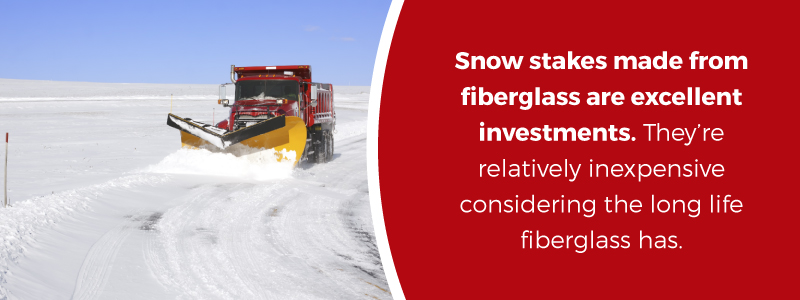
- Plastic: It’s not as common to see plastic driveway markers or buried hazard warning stakes. Plastic is exceptionally tough and durable, but it tends to be thicker and heavier. Plastic stakes also cost more money. But for semi-permanent installations, plastic stakes last indefinitely. They’re also larger and can support specific warning signs and even company marketing materials.
- Metal: These are the least common snow stakes. Although galvanized metal has perfect rot and rust resistance, the weight is a definite disadvantage for marking large areas. Metal stakes are the most expensive option, but for durability and longevity, they can’t be beat. Be cautious about using metal snow stakes anywhere near public property as many organized districts have banned them. Often, metal stakes have sharp edges which present a safety hazard, and when inadvertently struck by a snowplow, they can become airborne projectiles — making them highly dangerous to operators or anyone in the vicinity.
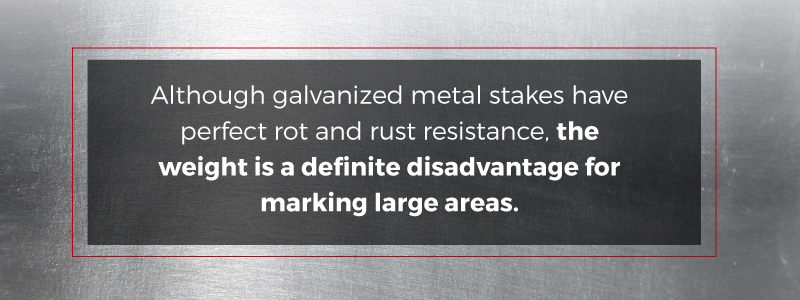
Using your snow stakes is a common sense issue. No two properties are alike when it comes to snow coverage. A rule-of-thumb is to use stakes wherever you feel there’s potential for something to get damaged during snow removal. That includes piling excess snow as well as pushing snowbanks.
Chances are, you’ll know where to mark your lawn and other vulnerable objects because of experience. You might have had lawn edges torn by previous snowplows or a shrub squashed by piled snow. Hopefully, you’ve never had a hydrant smashed or your buried Wi-Fi communications connection severed.
That begs the question of, “Where do I stake my yard?” That doesn’t mean what objects to mark. It means where to place your snow stakes in relation to the protection place.
Where to Stake Your Yard
Snow stake placement depends entirely on your property layout. Consider that snow stakes are often referred to as boundary demarcation indicators. That’s a fancy phrase for a visible stick, but it means this starts the no-go zone for snow plowing.
There’s an unwritten rule about stake placement. It falls in the common sense category. That’s to always place your lawn protective stakes ahead of what you’re protecting. How far is a good question. It seems that one to two feet forward from your lawn edge is a safe distance, but that might not always be possible.
Consider the very common situation where lawns run right up to asphalt driveways. The only realistic placement is right at the soft to solid surface edge. Most plow people will recognize a pattern and decipher the plowing area from the overall placement pattern. Plus, competent plow operators know not to hit the stakes. They do this all the time and know what snow stakes mean.
Staking in a straight line is simple. The challenge to effective snow plow marking is when curves are a part of the landscape. Put yourself in your snow plow driver’s seat and look out over a fresh snow covering across an entire yard. Without limit indicators, the operator has no idea what the layout is.
Staking Your Curves
Staking curves is all about standing back and envisioning how a plow driver will see your property after a snowfall. Look at your entire area to be plowed and pick out the high points where your curves extend and recess. Those are the first places to stake. That’s followed by fill-in, radius markers until you’ve painted a stake picture that clearly shows the pattern.
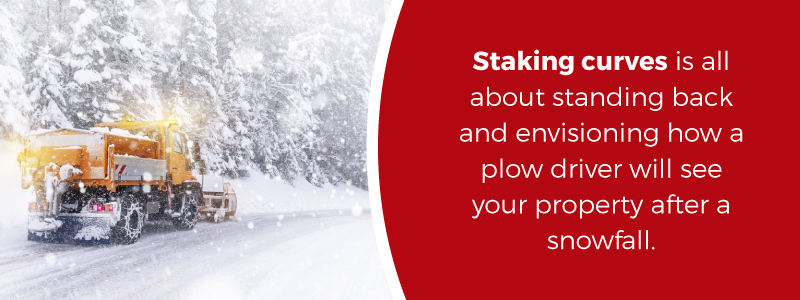
Staking important objects like walks, walls, curbs and catch basins is also a high priority. This is where you get creative. But, that’s as long as your operator is on the same page. Many people place a single stake at the front-center of a plow hazard. That’s a clear message to keep back.
Some people prefer to mark each hazard side. There’s a drawback to this as too many stakes creates a confusing forest of foreign uprights. Keep it simple, as they say. The best solution to clearly identifying different hazard types is color-coding your snow stakes.
Color Coding Your Markers
You can buy color-coded markers through many outlets. There’s no universal color-coding for snow demarcation like there is for electrical codes. The main thing is that colors mean something different and your plow driver understands the coding. Suggestions for marking your yard with color-coded snow stakes are:
- Green: This color is best to signify living plants like grass and shrubs. Green can also mark planting beds and low hedges.
- Red: High safety hazards should be red flagged. Red is a universal warning color, and it’s the right choice for dangerous obstacles like fire hydrants, gas meters and electrical transformers.
- Orange: Lesser hazards that are dangerous to the snowplow should be suggested with orange. That might be solid-strike surfaces like curbs and walls.
- Yellow: You might stake precaution spots with yellow. That’s places like driveway ends or areas where snow piles should be placed.
- Blue: Water services are normally marked with blue indicators. That can be your water meter or your drain catchment basins. Catch basins are one of the first things plow operators pay attention to as it’s vital to free drains up to prevent melt flooding.
- White: This might not be a good idea even if on the top of a brightly colored snow stake. White will disappear in the background, and that’s not effective marking.
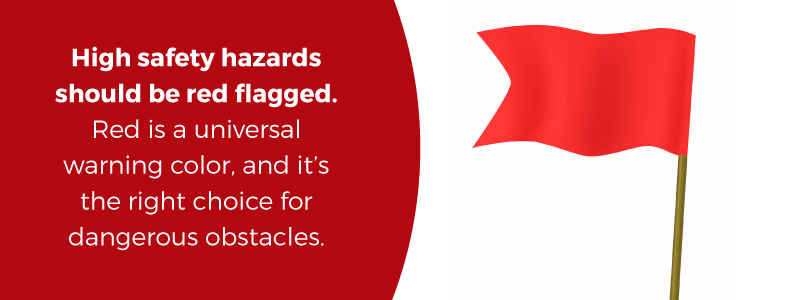
Once you’ve identified and selected your best snow stake materials, formed a placement pattern and arranged an effective color coding system, it’s time to install them. Installation might be more difficult than it seems, though — especially if you’ve waited too long and the ground is frozen.
Placing Your Snow Stakes
Installing your boundary and hazard markers depends on the surface. Soft ground is easy going because you can manually push or shove a sharp-pointed stake into the earth. That’s not the same with hard ground once it’s frozen.
Planning and ingenuity are always helpful when laying out and installing your snow stakes. Your stake material type is a big factor in setting out markers. Most commercial stakes have pre-sharpened ends that pierce their way into the soil and sit stationary. They rely on soil density to support their weight as well as wind and snow forces. That’s improved once the ground freezes and stays solid to spring when stakes are ready for removal.
There are a few tricks to the staking game. Again, it matters what type of stake material you have and where you’re putting them. These are the common marker installation methods:
- Manual Force: The simplest method is shoving a sharp stake into the soil. Some commercial markers have steel tips making installation in hard ground possible by hand-shoving.
- Drilling Holes: This trick is clever. You take a cordless drill equipped with an old auger bit and drill a hole deep enough to insert your stake. Obviously, this is for round stakes, which are the common commercial design.
- Installation Tools: Commercial snow stake suppliers have interesting tools that help you place snow stakes. They look like long steel bars or pipes with a sharp lower edge and a foot brace welded on. You step on the bar applying force to pierce the ground.
- Stake Sleeves: These are permanent receptacles installed on hard surfaces. Sleeves are plastic or metal tubes precast in concrete or pavement that accept stakes without hassle.
- Concrete Blocks: Some ambitious homeowners cast concrete blocks to place at important hazards. These blocks have stake sleeves pre-installed and are used year after year.
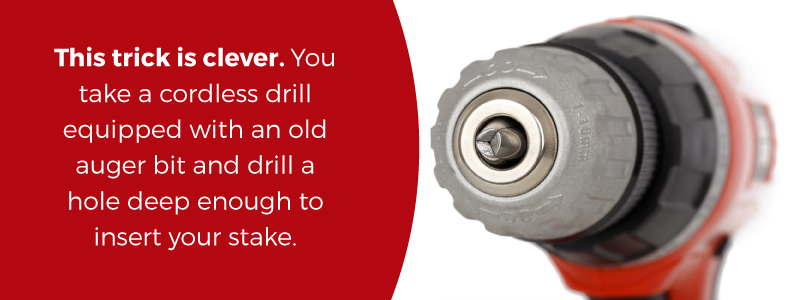
Lawn Stake Spacing Guidelines
You might be wondering how far apart to place your lawn stakes. This question has no right answer. “It depends” is an overused phrase, but it’s entirely applicable to your particular property. Stake placement varies depending on how many hazards you need to mark and where they are. It also depends on your property size and how long your plowing distances are.
Some owners flag or mark their demarcation lines every 20 to 50 feet for continuous runs. That’s ample to let a plow driver follow along. Bigger marking spans save in stake costs. They also have a less cluttered look to your property.
Curved areas can eat up the stakes. You might need placement every 10 to 20 feet to form a clear pattern. The important issue is protecting property and equipment. It’s as critical for the snow removal company to know the hazards as it is for you to identify them.
This is where it’s vital to build a working relationship with your snow removal contractor. Reputable snow removers are fully aware of many hazards they find on removal sites. It’s a great idea to work with your snow plow contractor to plan ahead. Ask them to help you develop a lawn-staking plan. Professional snow removers will also recommend the right stake materials as well as an efficient and easily identifiable color coding.
Ricci’s Landscape Management for Your Snow Removal Needs
Ricci’s Landscape Management, Inc. is your first choice for snow removal in Northwest Indiana. We’ve been in business since 1994, providing professional and dependable snow removal throughout the winter season. Ricci’s provides residential and commercial snow plowing for driveways, parking lots, sidewalks and pathways for safe and secure passage. That’s for both people and vehicles.
Ricci’s Landscape Management, Inc. has different snow removal services for different situations. We have comprehensive snow and ice removal contracts for every application. Our snow services include:
- Snow plowing
- Snow removal
- Sidewalk shoveling
- Snow blowing
- Sidewalk salting & deicing
We’re also professionally trained for hazard identification and bonded for insurance against accidents. Get in touch with Ricci’s Landscape Management, Inc. for all your snow service needs. Call us at 800-595-4339 and request a quote today.








